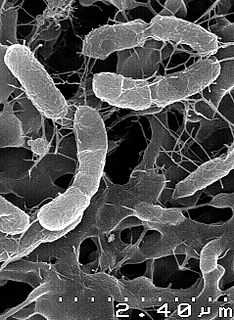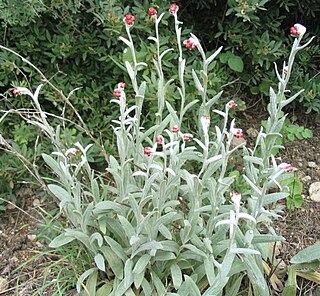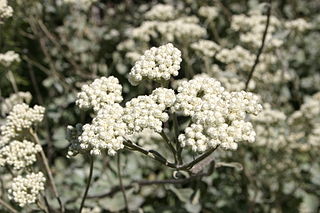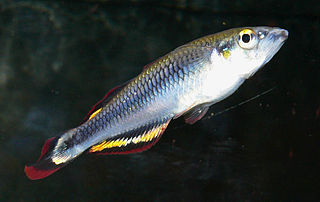
The Aquificae phylum is a diverse collection of bacteria that live in harsh environmental settings. The name 'Aquificae' was given to this phylum based on an early genus identified within this group, Aquifex, which is able to produce water by oxidizing hydrogen. They have been found in springs, pools, and oceans. They are autotrophs, and are the primary carbon fixers in their environments. These bacteria are Gram-negative, non-spore-forming rods. They are true bacteria as opposed to the other inhabitants of extreme environments, the Archaea.

The genus Helichrysum consists of an estimated 600 species of flowering plants in the sunflower family (Asteraceae). The type species is Helichrysum orientale. The name is derived from the Greek words ἑλίσσω and χρῡσός.

Helichrysum petiolare, the licorice-plant or liquorice plant, is a species of flowering plant in the family Asteraceae, native to South Africa — where it is known as imphepho — and naturalized in parts of Portugal and the United States. Growing to about 45 cm (18 in) high and 150 cm (59 in) broad, it is a trailing evergreen subshrub with furry grey-green leaves and small white flowers. Other common names include silver-bush everlastingflower, trailing dusty miller and kooigoed. The foliage has a faint licorice aroma, but Helichrysum petiolare is not closely related to the true liquorice plant, Glycyrrhiza glabra.

Xerochrysum is a genus of flowering plants native to Australia. It was defined by Russian botanist Nikolai Tzvelev in 1990, preceding Bracteantha which was described the following year. A 2002 molecular study of the tribe Gnaphalieae has indicated the genus is probably polyphyletic, with X. bracteatum and X. viscosum quite removed from each other.

Apristurus is a genus of catsharks, the family Scyliorhinidae, commonly known as the ghost or demon catsharks.

The Gemmatimonadetes are a phylum of bacteria established in 2003. The phylum contains two classes Gemmatimonadetes and Longimicrobia.
Mycobacterium chubuense is a species of the phylum Actinobacteria, belonging to the genus Mycobacterium.
The family Cytophagaceae is composed of eleven genera of environmental bacteria. The proposed genus "Allopseudarcicella" was recognized as a later synonym of Aquirufa and its sole species "Allopseudarcicella aquatilis" was transferred to the species Aquirufa nivalisilvae.

Bedotia is a genus of the family Bedotiidae of fishes endemic to Madagascar.
Helichrysum sp. nov. B is a species of flowering plant in the family Asteraceae. It is found only in Yemen. Its natural habitats are subtropical or tropical dry shrubland and rocky areas.
Helichrysum sp. nov. C is a species of flowering plant in the family Asteraceae. It is found only in Yemen. Its natural habitat is rocky areas. It is threatened by habitat loss.
Helichrysum sp. nov. D is a species of flowering plant in the family Asteraceae. It is found only in Yemen. Its natural habitat is rocky areas.
Helichrysum sp. nov. E is a species of flowering plant in the family Asteraceae. It is found only in Yemen. Its natural habitat is rocky areas.

Cronobacter is a genus of Gram-negative, facultatively anaerobic, oxidase-negative, catalase-positive, rod-shaped bacteria of the family Enterobacteriaceae.
The Chloroflexi or Chlorobacteria are a phylum of bacteria containing isolates with a diversity of phenotypes, including members that are aerobic thermophiles, which use oxygen and grow well in high temperatures; anoxygenic phototrophs, which use light for photosynthesis ; and anaerobic halorespirers, which uses halogenated organics as electron acceptors.

Helichrysum luteoalbum, the Jersey cudweed, is a species of flowering plant in the daisy family Asteraceae.

The Haemoproteidae are a family of parasitic alveolates in the phylum Apicomplexa.
Merogregarina is a genus of parasitic alveolate in the phylum Apicomplexa. Species in this genus infect marine invertebrates.
The Natranaerobiales are an order of bacteria placed within the class Clostridia. This order contains the thermophilic bacterial species Natranaerobius thermophilus and the related species Natranaerobaculum magadiense.
The Orbales are an order of Proteobacteria with the single family Orbaceae. This order was created to accommodate novel bacterial species isolated from the guts of honeybees and bumblebees.










